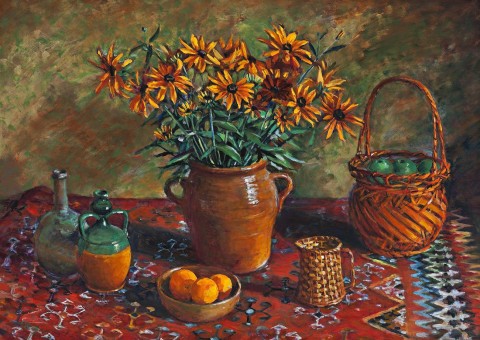RUDBECKIAS WITH CANE BASKET, c.1981 – 82
MARGARET OLLEY
oil on composition board
76.0 x 106.5 cm
signed lower left: Olley
Solander Gallery, Canberra
Private collection
Sotheby's, Melbourne, 30 April 2002, lot 17 (as ‘Still Life with Flowers and Fruit’)
Savill Galleries, Sydney, 2004
Private collection, Canberra
Margaret Olley, Solander Gallery, Canberra, 17 March – 18 April 1982, cat. 3
Unswayed by the tide of late Modernism, Margaret Olley was forever steadfastly devoted to the humble still life. As observed by Olley's dear friend Edmund Capon, ’Still-lifes and interiors are her métier, and Margaret Olley is a part of that tradition, from Vermeer in the seventeenth century to Morandi in the twentieth century – two of her most admired artists – which finds inspiration, beauty and a rich spirit of humanity in the most familiar of subject matter.’1 Painted just after the artist returned from a sojourn to Asia, United States and the United Kingdom in 1981, during which she eagerly attended exhibitions by Henri Matisse and Giorgio Morandi, Rudbeckias with Cane Basket, c.1981 – 82 is a prime example of Olley’s masterful manipulation of light and space.
The warm summer sunlight, casting long shadows across the kilim covered table surface, contributes to an ostensibly prosaic composition in Rudbeckias with Cane Basket. However, this ambience conceals a carefully considered orchestration of space. Arranged and rearranged like props in a theatre set, the objects in Olley’s paintings are meticulously placed and, in time, became as familiar to viewers as they were to the artist herself. The two-handled pot, cane basket and kilim rug are all recurring ‘characters’ on her stage, imbued with the stories and memories of her colourful life. The striking Rudbeckias set against the familiar green walls of her kitchen pay homage to her beloved European tradition of nature morte painting in a delicately constructed mise en scène. As Barry Pearce elucidates in the Art Gallery of New South Wales retrospective publication, there is more to Olley’s paintings than a mere still-life – we are invited into her personal domain: ’Darkness and light, fertility and decay, space and time, tragedy and comedy, solitude, camaraderie; all the things we know and imagine about life and humanity can be gathered at her table within the rooms of her world’.2
The artist endlessly found magic in the unremarkable, revelling in the beauty and warmth of her Paddington terrace home. The balance and harmony found in Rudbeckias with Cane Basket reflects the very essence of the artist's own domestic existence. As her close friend, Barry Humphries poeticised:
The rugs, the jugs, congealing cups of tea
The Chinese screen and old Matisse’s prints,
Cosier and richer than the QVB
Is Olley’s kitchen with its glows and glints.3
1. Capon, E., quoted in Pearce, B., Margaret Olley, The Art Gallery of New South Wales, Sydney, 1996, p. 7.b
2. Pearce, B., Margaret Olley, Art Gallery of New South Wales, Sydney, 1997, p. 21
3. Humphries, B., ‘Ode to Olley’ in Alderton, S., Margaret Olley: Home, Museum of Sydney, Sydney, 2012, p. 17
MELISSA HELLARD
